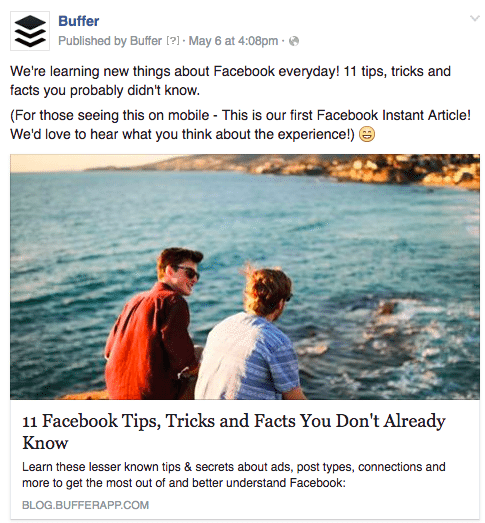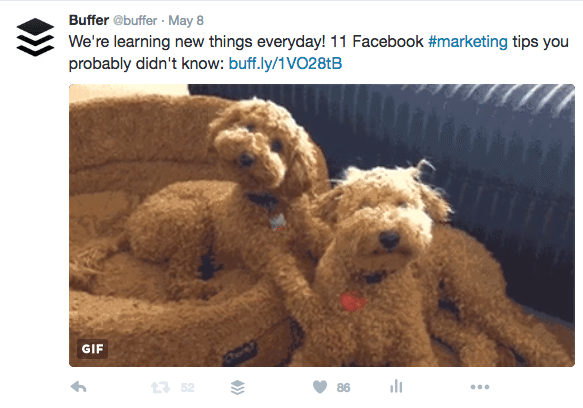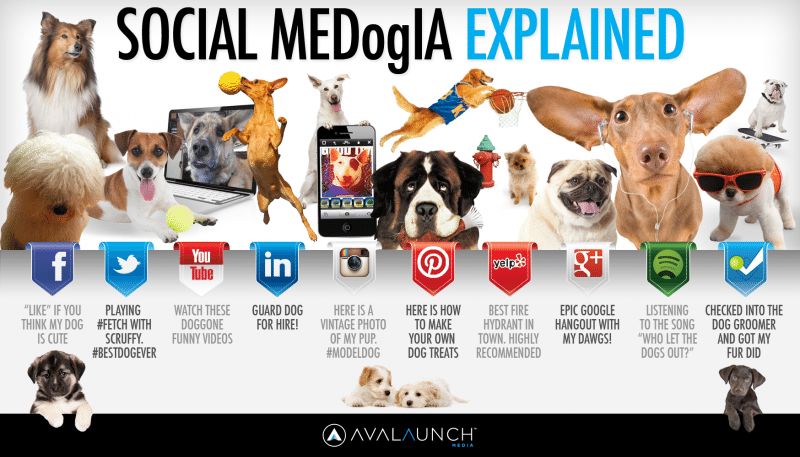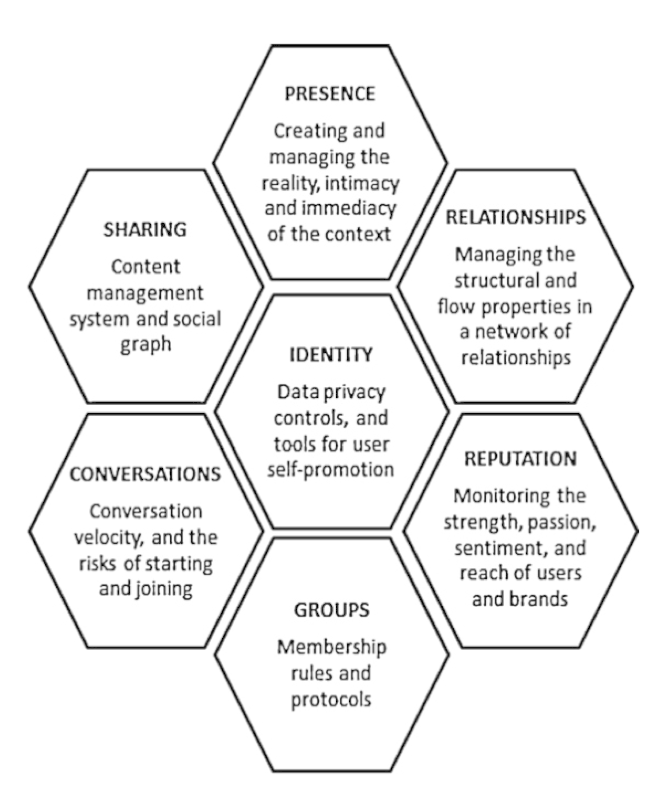You’ve crafted the perfect blog post: Well-researched, SEO optimized, contains the ideal keyword ratio with trustworthy outbound and internal links, and it even has a nifty infographic that you spent hours to create.
All you have to do is queue it up in Buffer and watch it take off, right?
I’ve been there, and I wish it were true!
Social media managers and marketers know that sometimes even the most epic material requires love and hard work when it comes to promoting content across social media.
But with the right combination of strategy, effort, and luck you really can get your amazing content to succeed on social media.
Start here with these 6 proven strategies for promoting content across social media – They’ve worked for us, and they can work for you as well.
Let’s jump in!
1. Create unique posts for each social channel
With limited time and resources, creating a unique post for each social media channel can be a challenge, but it’s well-worth the effort. This will help to give your content a fresh feel no matter where your audience lands and show that you’ve put some thought into each update.
The other benefit of creating a unique post is that each social media channel has its own set of rules and so what works on one channel may not work on the other.
Take our recent article on 11 Facebook Marketing Features for example:
Here’s how we shared it on Facebook:

And on Twitter:

From past experience on social media, we know that our Facebook audience tends to like a bit more context around a blog post, whereas our Twitter followers tend to engage with tweets that are to-the-point and contain awesome visuals.
The visual here being this adorable puppy GIF (animal GIFs highly recommended!)
Here’s how I like to think of promoting content across social media before I craft a post – Helping me to consider the potential audience and what they might respond to:
- Twitter: An audience looking for news, tips, Twitter best-practices, how-to’s, interesting articles, and what’s trending. Quick, witty, and eye-catching updates are a social media manager’s best friend.
- Facebook: An audience looking for entertainment and value. Think, “share” first. What will make your audience want to share your post? Aim to spark emotions and interest with captions and headlines.
- Instagram: An audience looking for stunning visuals. Which portion of your content is the most visually-pleasing piece? Share that! If there’s none, try creating an image to share with Canva.
- LinkedIn: An audience of professionals. How will your piece of content add value to the professional lives of your audience? Try and express those professional benefits in your LinkedIn updates.
- Pinterest: An audience of creatives. Think beautiful images plus how-to’s. As much content as you can clearly fit into a visual, the better – Infographics are a perfect medium to accomplish this.
Keeping with the puppy theme, here’s another great way to think of each channel before posting:

Image via Avalaunch Media
2. Become a social media outreach expert
It would be great if promoting content across social media was similar to Kevin Costner in the movie Field of Dreams – the “build it and they will come” strategy.
In the early days of social media, we were enjoying a mountain of organic traffic and engagement on social media until slowly, but surely, those results began to decline, and we lost nearly half of our social media traffic.
Since then, we’ve had to pivot and focus on what we can do internally to get the most out of our blog content on social. Inspired by a post on outreach by Jeff Bullas, we now like to think of ourselves as outreach experts.
One of the keys to social media outreach that we’ve discovered is that it’s not the number of people that you reach out to, it’s the type of people.
We broke the “types” up into 3 categories:
Advocates
These are the faithful audience members of your brand. The amazing people that retweet every one of your tweets and like every one of your Facebook posts. The ones that talk about your product or service to their friends and family.
Providing value to these loyal audience members is encouraged on both social media and email. If you haven’t already, consider creating a weekly email newsletter or roundup with the top posts from your blog.
Include your social media icons in the email and even experiment with asking your subscribers to share the content – turning them from subscribers to social media fans.
Peers
These are the people and/or brands in your field that you would consider peers – The ones looking to gain the attention of the same people (more or less) that you are. When it comes to marketing to a similar audience, we’ve found that it is effective to work with peers as it increases your potential audience size and is good business as it benefits both parties.
Working with peers can be as easy as agreeing to curate and share each other’s content on social media, teaming up on a blog post, or going a bit deeper by creating free resources that your audience will find useful.
Start by messaging the content manager or social media manager from the company that you’re interesting in working with on social media or email with a few valuable partnership ideas and what the benefits on both ends will be.
Big Fish
Connecting with influencers and “big fish” companies may not be as hard as many people think it is. At the end of the day, they’re all human just like you and me. The only difference is they’ve amassed a huge audience after years of hard work.
According to Jeff Bullas, there are a few basic principles when connecting with an influencer:
- Always provide value for the influencer
- Expect nothing in return
- Be polite
- Act like a human being
Providing value is first and foremost. What can and will you bring to the table that will benefit them? Over time, this will build into a mutually beneficial and trusting relationship.
A great example of this is when HubSpot reached out to us with an opportunity to partner up on a social media content calendar template. They had already done much of the work (value) and were looking for a partner to promote this resource to audiences (trust). It was a no-brainer for us to dive in with them.
3. Optimize posting timing & frequency
One question that we get asked a lot here at Buffer is: How often should I post to social media?
I love this question because it makes me take a good look at what is and isn’t working when promoting content across social media on our own channels. The one answer I always find is that it’s constantly changing – What works for us one week is different the next. That’s why I’m always experimenting with our schedule and why I encourage you to do the same.
Here’s a fun little 3-week posting experiment that I ran on across social media to see if post timing would make a big difference in clicks and engagement:
Week 1:
- Facebook: Post 5 times per day at “peak” Facebook times (using Facebook Insights)
- Twitter: Post 14 times per day at “peak” Twitter times (using Buffer’s Optimal Timing Tool)
- Instagram: Post 1 time per day with our “peak” Instagram time (using Iconosquare)
- LinkedIn: Post 4 times per day during USA working hours (5:00 a.m. – 8:00 p.m. PST)
Week 2:
- Facebook: Post 4 times per day at “peak Facebook times” (using Buffer Analytics)
- Twitter: Post 13 times per day at “peak Twitter times” (using Buffer’s Optimal Timing Tool)
- Instagram: Post 1 time per day with experimenting with 6 “new” times (using Iconosquare)
- LinkedIn: Post 4 times per day during randomly assigned times throughout the day
Week 3:
- Facebook: Post 3 times per day at “non-peak” Facebook times (using Buffer Analytics)
- Twitter: Post 11 times per day at “non-peak” Twitter times (using Buffer’s Optimal Timing Tool)
- Instagram: Post 1 time per day with our “peak” and “non-peak” times (using Iconosquare)
- LinkedIn: Post 3 times per day during USA working hours and on weekends
Though it wasn’t a perfect experiment, I acquired a ton of internal data from just 3 weeks of easy-to-implement social media experiments.
What I found was a “sweet spot” between engagement and clicks. We have a highly active audience between the hours of 12:00 – 3:00 a.m. PST on many of our social media channels. Awesome!
I then used that data to schedule our most important and potentially engaging posts around those times to give them a little extra boost.
4. Test social media headlines
On the average, five times as many people read the headline as read the body copy. When you have written your headline, you have spent eighty cents out of your dollar. – David Ogilvy
Described as “The Father of Advertising,” David Ogilvy knew a thing or two about the importance of headlines.
An incredible study from the team at Ripenn gave us access to headline analysis from top viral sites on the web – what we observed from the data is that content that aims to help and provide value to others performed the best.
What better way to convey value in a short amount of time than through a well-written headline?
Garrett Moon, Founder at CoSchedule, analyzed more than 1 million headlines and came up with some great tips for maximizing their potential. We then mixed those with our own data and created these 10 takeaways for writing great headlines:
5. Utilize Call-to-Action (CTAs) regularly
In an ideal marketing world, people would hear about your product or service from friends and family on social media, check out your profiles, follow your accounts and like your posts, visit your website, and convert into a paying customer.
Call-to-Action (CTAs) are a great way to encourage your audience to like, share, and engage with the awesome content that you are creating and to eventually capture leads from social media.
But when promoting content across social media, it’s important to fit CTAs in naturally. Aim to be as genuine, creative, and original as possible. For tips and call-to-action inspiration, check out these 30 examples you can’t help but click.
If those don’t quite hit the spot, here are a few more ideas that have worked for us in the past:
- Ask thought-provoking questions
- Host a giveaway asking participants to “share this post, “tag a friend,” or “follow us on social”
- Include CTAs in beautiful social media images
- Offer additional free content and resources where no signup is required
6. Build a social media community
If you’re experimenting with all of the tactics above and looking for even more ways to reach a new audience, building a social media community is a great next step.
Your brand’s “tribe” helps people stay connected, informed, and talking even when you’re asleep.
At the crux of a social media community is this idea:
For companies and brands to build strong relationships online, communication must be a two-way street.
Whether you build your community on Slack, LinkedIn, Facebook, Twitter Chats, or a host of other online options, the most important part is your brand’s two-way interaction with real people.
Your brand is at the center of your community, but the goal is to give participants an identity and a voice where they can share their thoughts about big topics in your industry. Listen to their questions, concerns, thoughts, and ideas and respond to them in an authentic way.

Image: “The Honeycomb of Social Media”
At the end of the day, good content, quick responses, and a real person to monitor and interact through your social media channels will do wonders for your social marketing campaign.
Over to you
What are your go-to strategies when promoting content on social media?
- Do you share content more than once?
- Have you found your timing sweet-spot?
- Which social media networks drive the most traffic and engagement for you?
- Do you run A/B tests for each one of your headlines?
We’d love to hear from you in the comments below!
Try Buffer for free
190,000+ creators, small businesses, and marketers use Buffer to grow their audiences every month.


